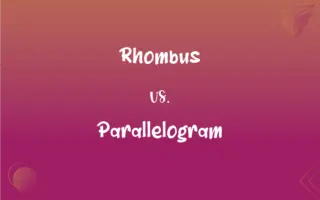Diffusion vs. Active Transport: What's the Difference?
Edited by Janet White || By Harlon Moss || Updated on October 27, 2023
Diffusion is the passive movement of particles from high to low concentration; active transport requires energy to move particles against the concentration gradient.

Key Differences
Diffusion is a passive process where particles move from an area of higher concentration to an area of lower concentration. Active transport is an energy-requiring process that moves particles against their concentration gradient.
In diffusion, no energy is required as it is driven by the natural kinetic energy of particles. However, active transport requires cellular energy (often ATP) to move substances across cell membranes.
While diffusion occurs naturally and can happen in any medium (gas, liquid, or solid), active transport is a biological process, mostly occurring in living cells.
Diffusion is crucial for processes like gas exchange in lungs and distribution of nutrients in cells. Active transport, on the other hand, is essential for maintaining concentrations of ions and other substances necessary for cell functions.
Active transport can move substances from a lower to a higher concentration, which is not possible through diffusion. This is vital for processes like nutrient absorption in the intestines and ion transport in nerve cells.
ADVERTISEMENT
Comparison Chart
Energy Requirement
Does not require energy.
Requires energy (usually ATP).
Concentration Gradient
Moves particles from high to low concentration.
Moves particles against the concentration gradient.
Process Type
Passive process.
Active, energy-driven process.
Occurrence
Can occur in any medium.
Occurs in living cells.
Function
For general movement of particles.
For specific transport of substances.
ADVERTISEMENT
Diffusion and Active Transport Definitions
Diffusion
A natural process requiring no energy input.
Diffusion of ink in water creates a beautiful pattern.
Active Transport
Cellular process requiring ATP.
Active transport helps maintain ion balance in nerve cells.
Diffusion
Passive spread of substances across a gradient.
Oxygen enters the bloodstream through diffusion in the lungs.
Active Transport
Movement of substances using energy.
Active transport is essential for nutrient absorption in cells.
Diffusion
The scattering of light particles through a medium.
Diffusion of sunlight through the clouds creates a soft light.
Active Transport
Energy-driven transport against a gradient.
Sodium-potassium pumps use active transport.
Diffusion
Gradual mixing of molecules in a solution.
The sugar eventually dissolved through diffusion.
Active Transport
Movement of ions across cell membranes.
Calcium ions are moved into the cell via active transport.
Diffusion
Movement of particles from high to low concentration.
The diffusion of perfume in the air made the whole room fragrant.
Active Transport
Selective transport of specific molecules.
Glucose is often absorbed into cells through active transport.
Diffusion
The process of diffusing or the condition of being diffused
The diffusion of new technology around the world.
FAQs
What is active transport?
Active transport is the energy-requiring movement of substances against a concentration gradient.
What is diffusion?
Diffusion is the passive movement of particles from higher to lower concentration.
Does diffusion require energy?
No, diffusion is a passive process and does not require energy.
Is active transport necessary for nerve function?
Yes, active transport is crucial for maintaining ion gradients in nerve cells.
Can diffusion occur in a vacuum?
No, diffusion requires a medium for the particles to move through.
What energy source does active transport use?
Active transport typically uses ATP (adenosine triphosphate) as an energy source.
Can diffusion happen in dead organisms?
Yes, as diffusion is a passive process, it can occur in non-living systems.
Is active transport reversible?
Yes, active transport can be reversible depending on the cell's needs.
What role does active transport play in the kidneys?
Active transport helps in the reabsorption of vital substances in the kidneys.
Is facilitated diffusion the same as active transport?
No, facilitated diffusion is passive and doesn't require energy, unlike active transport.
Can active transport occur in all cells?
Active transport occurs in many cells, especially those needing specific substances.
Is active transport a selective process?
Yes, active transport is selective and often involves specific transport proteins.
Where does diffusion commonly occur?
Diffusion occurs in various mediums including gases, liquids, and solids.
How does temperature affect diffusion?
Higher temperatures generally increase the rate of diffusion.
Does active transport always involve membrane proteins?
Most active transport processes involve specific membrane proteins.
Can diffusion equalize concentrations on both sides of a membrane?
Yes, diffusion can lead to an equilibrium of concentrations.
Is osmosis a form of diffusion?
Yes, osmosis is the diffusion of water across a semi-permeable membrane.
Do all molecules diffuse at the same rate?
No, the rate of diffusion varies based on molecule size and medium.
Are active transport mechanisms always present in cell membranes?
Yes, most cells have active transport mechanisms to regulate internal conditions.
Can diffusion move substances against the concentration gradient?
No, diffusion only moves substances from higher to lower concentration.
About Author
Written by
Harlon MossHarlon is a seasoned quality moderator and accomplished content writer for Difference Wiki. An alumnus of the prestigious University of California, he earned his degree in Computer Science. Leveraging his academic background, Harlon brings a meticulous and informed perspective to his work, ensuring content accuracy and excellence.
Edited by
Janet WhiteJanet White has been an esteemed writer and blogger for Difference Wiki. Holding a Master's degree in Science and Medical Journalism from the prestigious Boston University, she has consistently demonstrated her expertise and passion for her field. When she's not immersed in her work, Janet relishes her time exercising, delving into a good book, and cherishing moments with friends and family.







































































